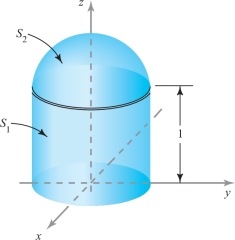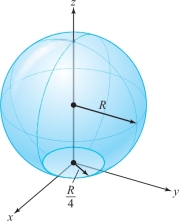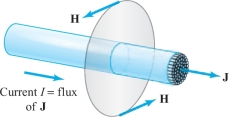Exercises for Section 18.2
Question 18.44
Let \(S\) be the portion of the plane \(2x + 3y + z = 5\) lying between the points \((-1,1,4)\), \((2,1,-2)\), \((2,3,-8)\), and \((-1,3,2)\). Find parameterizations for both the surface \(S\) and its boundary \(\partial\! S\). Be sure that their respective orientations are compatible with Stokes’ theorem.
Question 18.45
Let \(S\) be the portion of the surface \(z = x^2 + y^2\) lying between the points \((0,0,0)\), \((2,0,4)\), \((0,2,4)\), and \((2,2,8)\). Find parameterizations for both the surface \(S\) and its boundary \(\partial\! S\). Be sure that their respective orientations are compatible with Stokes’ theorem.
In the next four exercises, verify Stokes’ theorem for the given surface S and boundary \(\partial\! S\), and vector fields \(\textbf{F}\).
Question 18.46
\begin{eqnarray*} S & = & \{ (x,y,z) : x^2 + y^2 + z^2 = 1, \quad z \geq 0 \} \\[4pt] &&\quad \hbox{(oriented as a graph)}\\[4pt] \partial\! S & = & \{ (x,y) : x^2 + y^2 = 1 \} \\ \textbf{F} & = & x \textbf{i} + y \textbf{j} + z \textbf{k}\\[-19pt] \end{eqnarray*}
Question 18.47
\(S\) as in (1), and \(\textbf{F} = y \textbf{i} + z \textbf{j} + x \textbf{k}\)
Question 18.48
\begin{eqnarray*} S & = & \{ (x,y,z) : z = 1- x^2 - y^2, \quad z \geq 0 \} \\[4pt] &&\quad \hbox{(oriented as a graph)}\\[4pt] \partial\! S & = & \{ (x,y) : x^2 + y^2 = 1 \} \\ \textbf{F} & = & z \textbf{i} + x \textbf{j} + (2zx + 2xy) \textbf{k} \end{eqnarray*}
Question 18.49
\(S\) as in (3), and \(\textbf{F} = z^2 \textbf{i} + x \textbf{j} + y^2 \textbf{k}\)
Question 18.50
Let \(C\) be the closed, piecewise smooth curve formed by traveling in straight lines between the points \((0,0,0)\), \((2,0,4)\), \((3,2,6)\), \((1,2,2)\), and back to the origin, in that order. (Thus the surface \(S\) lying interior to \(C\) is contained in the plane \(z=2x\).) Use Stokes’ theorem to evaluate the integral: \[ \int_{C} (z \cos x)\, {\it dx} + (x^2 y z)\, {\it dy} + (yz)\, dz \]
451
Question 18.51
Let \(C\) be the closed, piecewise smooth curve formed by traveling in straight lines between the points \((0,0,0)\), \((2,1,5)\), \((1,1,3)\), and back to the origin, in that order. Use Stokes’ theorem to evaluate the integral: \[ \int_{C} (xyz)\,{\it dx} + (x y)\,{\it dy} + (x)\,dz \]
Question 18.52
Redo Exercise 9 of Section 17.6 using Stokes’ theorem.
Question 18.53
Redo Exercise 10 of Section 17.6 using Stokes’ theorem.
Question 18.54
Verify Stokes’ theorem for the upper hemisphere \(z= \sqrt{1-x^2- y^2}, z \ge 0\), and the radial vector field \({\bf F} (x,y,z)= x {\bf i} + y {\bf j} +z {\bf k}\).
Question 18.55
Let \(S\) be a surface with boundary \(\partial\! S\), and suppose \({\bf E}\) is an electric field that is perpendicular to \(\partial\! S\). Show that the induced magnetic flux across \(S\) is constant in time. (HINT: Use Faraday’s law.)
Question 18.56
Let \(S\) be the capped cylindrical surface shown in Figure 18.23. \(S\) is the union of two surfaces, \(S_1\) and \(S_2\), where \(S_1\) is the set of \((x,y,z)\) with \(x^2 + y^2=1, 0 \le z \le 1\), and \(S_2\) is the set of \((x,y,z)\) with \(x^2 + y^2 + (z-1)^2 =1, z \ge 1\). Set \({\bf F} (x,y,z) = (zx + z^2 y + x) {\bf i} + ( z^3 yx + y) {\bf j}+ z^4 x^2 {\bf k}\). Compute \({\intop\!\!\!\intop}_S ( {\nabla}\times {\bf F}) \,{\cdot}\, d {\bf S}\). (HINT: Stokes’ theorem holds for this surface.)

Question 18.57
Let \({\bf c}\) consist of straight lines joining \((1, 0, 0), (0, 1, 0)\), and \((0, 0, 1)\) and let \(S\) be the triangle with these vertices. Verify Stokes’ theorem directly with \({\bf F} = yz {\bf i} + xz {\bf j}+ xy {\bf k}\).
Question 18.58
Evaluate the integral \({\intop\!\!\!\intop}_S ({\nabla} \times {\bf F}) \,{\cdot}\, d {\bf S}\), where \(S\) is the portion of the surface of a sphere defined by \(x^2 + y^2 + z^2=1\) and \(x+ y +z \ge 1\), and where \({\bf F}= {\bf r} \times ({\bf i} + {\bf j} + {\bf k}), {\bf r}= x {\bf i}+ y {\bf j} + z {\bf k}\).
Question 18.59
Show that the calculation in the previous exercise can be simplified by observing that \(\int_{\partial\! S} {\bf F}\,{\cdot}\, d{\bf r}=\int_{\partial\!\Sigma}{\bf F}\,{\cdot}\, d{\bf r}\) for any other surface \(\Sigma\). By picking \(\Sigma\) appropriately, \({\intop\!\!\!\intop}_{\Sigma} ({\nabla} \times {\bf F}) \,{\cdot}{\,d} {\bf S}\) may be easy to compute. Show that this is the case if \(\Sigma\) is taken to be the portion of the plane \(x+ y + z=1\) inside the circle \(\partial\! S\).
Question 18.60
Calculate the surface integral \({\intop\!\!\!\intop}_S ({\nabla} \times {\bf F}) \,{\cdot}\, d {\bf S}\), where \(S\) is the hemisphere \(x^2 {+} y^2 {+} z^2 = 1, x \ge 0\), and \({\bf F}= x^3 {\bf i} - y^3 {\bf j}\).
Question 18.61
Find \({\intop\!\!\!\intop}_S ({\nabla} \times {\bf F}) \,{\cdot}\, d {\bf S}\), where \(S\) is the ellipsoid \(x^2 + y^2 + 2 z^2 =10\) and \({\bf F}\) is the vector field \({\bf F} = (\sin xy) {\bf i} + e^x {\bf j} - yz {\bf k}\).
Question 18.62
Let \({\bf F} = y {\bf i} \,-\, x {\bf j} \,+\, z x^3 y^2 {\bf k}\). Evaluate \({\intop\!\!\!\intop}_S ({\nabla} \times {\bf F}) \,{\cdot}\, {\bf n} {\,d} A\), where \(S\) is the surface defined by \(x^2 \,+\, y^2 \,+\, z^2 =1, z \le 0\).
Question 18.63
A hot-air balloon has the truncated spherical shape shown in Figure 18.24. The hot gases escape through the porous envelope with a velocity vector field \begin{eqnarray*} &&{\bf V} (x,y,z) = {\nabla} \times {\Phi} (x,y,z)\\ &&\qquad\hbox{where}\qquad {\Phi} (x,y,z) = -y {\bf i}+ x {\bf j}. \end{eqnarray*}
If \(R=5\), compute the volume flow rate of the gases through the surface.

Question 18.64
Prove that Faraday’s law implies \({\nabla} \times {\bf E}= -\partial {\bf H} / \partial t\).
Question 18.65
Let \(S\) be a surface and let \({\bf F}\) be perpendicular to the tangent to the boundary of \(S\). Show that \[ \intop\!\!\!\intop\nolimits_{S} ({\nabla} \times {\bf F}) \,{\cdot}\, d {\bf S} =0. \]
What does this mean physically if \({\bf F}\) is an electric field?
452
Question 18.66
Consider two surfaces \(S_1, S_2\) with the same boundary \(\partial\! S\). Describe with sketches how \(S_1\) and \(S_2\) must be oriented to ensure that \[ \intop\!\!\!\intop\nolimits_{S_1} ({\nabla} \times {\bf F})\,{\cdot}\, {\,d} {\bf S} = \intop\!\!\!\intop\nolimits_{S_2} ({\nabla} \times {\bf F})\,{\cdot}\, d {\bf S}. \]
Question 18.67
For a surface \(S\) and a fixed vector \({\bf v}\), prove that \[ 2 \intop\!\!\!\intop\nolimits_{S} {\bf v} \,{\cdot}\, {\bf n}\, dS = \int_{\partial\! S} ({\bf v} \times {\bf r})\,{\cdot}\, d {\bf s}, \] where \({\bf r} (x,y,z) = (x,y,z)\).
Question 18.68
Argue informally that if \(S\) is a closed surface, then \[ \intop\!\!\!\intop\nolimits_{S} ({\nabla} \times {\bf F})\,{\cdot}\,d {\bf S} =0 \] (see the exercise two back). (A closed surface is one that forms the boundary of a region in space; thus, for example, a sphere is a closed surface.)
Question 18.69
If \(C\) is a closed curve that is the boundary of a surface \(S\), and \(f\) and \(g\) are \(C^2\) functions, show that
- (a) \(\displaystyle\int_C f {\nabla}\! g \,{\cdot}\, d {\bf s} = {\intop\!\!\!\intop}_S ({\nabla}\! f \times {\nabla} g) \,{\cdot}\, d {\bf S}\)
- (b) \(\displaystyle\int_C (f {\nabla}g + g {\nabla}f) \,{\cdot}\, d {\bf s} = 0\)
Question 18.70
- (a) If \(C\) is a closed curve that is the boundary of a surface \(S\), and \({\bf v}\) is a constant vector, show that \[ \int_C {\bf v} \,{\cdot}\,d {\bf s} =0. \]
- (b) Show that this is true even if \(C\) is not the boundary of a surface \(S\).
Question 18.71
Show that \({\Phi}\colon\, D \to {\mathbb R}^3, D = [0, \pi] \times [0, 2 \pi], {\Phi} (\phi, \theta) = (\cos \theta \sin \phi\), \(\sin \theta \sin \phi\), \(\cos \phi)\), which parametrizes the unit sphere, takes the boundary of \(D\) to half of a great circle on \(S\).
Question 18.72
Verify Theorem 6 for the helicoid \({\Phi} (r, \theta)= (r \cos \theta, r \sin \theta, \theta) , (r, \theta) \in [0,1] \times [0, \pi/2]\), and the vector field \({\bf F} (x,y,z) = (z,x,y)\).
Question 18.73
Prove Theorem 6.
Question 18.74
Let \({\bf F} = x^2 {\bf i}+ (2xy + x) {\bf j} +z {\bf k}\). Let \(C\) be the circle \(x^2 + y^2 =1\) and \(S\) the disc \(x^2 + y^2 \le 1\) within the plane \(z=0\).
- (a) Determine the flux of \({\bf F}\) out of \(S\).
- (b) Determine the circulation of \({\bf F}\) around \(C\).
- (c) Find the flux of \({\nabla} \times {\bf F}\). Verify Stokes’ theorem directly in this case.
Question 18.75
Let \(S\) be a surface with boundary \(\partial\! S\), and suppose that \(\bf E\) is an electric field that is perpendicular to \(\partial\! S\). Use Faraday’s law to show that the induced magnetic flux across \(S\) is constant in time.
Question 18.76
Integrate \({\nabla} \times {\bf F, F}= (3y, -xz, -yz^2)\) over the portion of the surface \(2z = x^2 + y^2\) below the plane \(z=2\), both directly and by using Stokes’ theorem.
Question 18.77
Ampère’s law states that if the electric current density is described by a vector field \({\bf J}\) and the induced magnetic field is \({\bf H}\), then the circulation of \({\bf H}\) around the boundary \(C\) of a surface \(S\) equals the integral of \({\bf J}\) over \(S\) (i.e., the total current crossing \(S\)). See Figure 18.25. Show that this is implied by the steady-state Maxwell equation \({\nabla} \times {\bf H} ={\bf J}\).

Question 18.78
Faraday’s law relates the line integral of the electric field around a loop \(C\) to the surface integral of the rate of change of the magnetic field over a surface \(S\) with boundary \(C\). Regarding the equation \({\nabla} \times {\bf E} = - \partial {\bf H} / \partial t\) as the basic equation, Faraday’s law is a consequence of Stokes’ theorem, as we have seen in Example 4.
Suppose we are given electric and magnetic fields in space that satisfy \({\nabla} \times {\bf E}= - \partial {\bf H} / \partial t\). Suppose \(C\) is the boundary of the Möbius band shown in the Figures in Section 17.6. Because the Möbius band cannot be oriented, Stokes’ theorem does not apply. What becomes of Faraday’s law? What do you guess \(\int_C {\bf E} \,{\cdot}\, d {\bf s}\) equals?
Question 18.79
- (a) If in spherical coordinates, we write \[ {\bf e}_r=\alpha {\bf i}+\beta{\bf j}+\gamma {\bf k}, \hbox{find}\ \alpha,\beta, \hbox{and}\ \gamma. \]
- (b) Find similar formulas for \({\bf e}_\phi\) and \({\bf e}_\theta\).